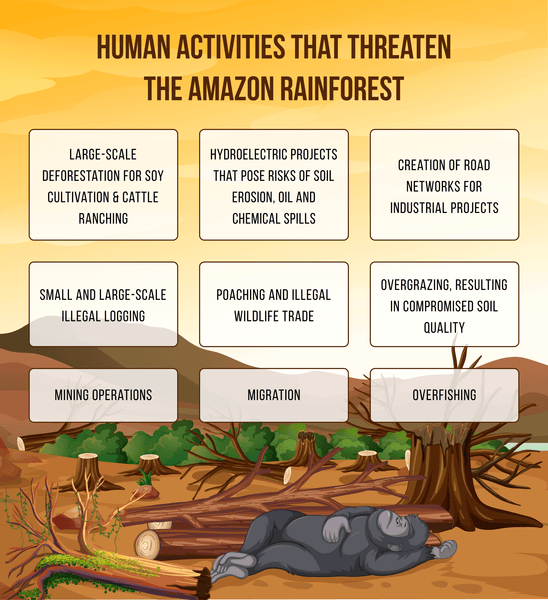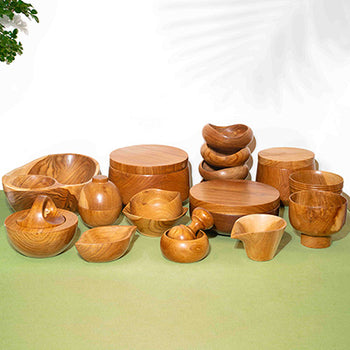The Amazon is the Earth’s largest rainforest and one of its richest ecosystems. It is the home of various flora and fauna, indigenous people groups, and rich cultures and traditions.
However, like most biodiversity hotspots of the world, the Amazon rainforest also faces several threats. Most of which are from natural factors, like forest fires, and human activities, like clearing lands for crops and pasture, excessive logging, mining, and illegal wildlife trade.
In this resource, we’ll dive deep into the latest Amazon Rainforest facts and stats. We’ll also tackle some of the most pressing questions about this ecosystem: What threats endanger the rainforest? Is the world’s oxygen supply at stake? How can leaders and ordinary people contribute to forest protection and conservation?
Amazon Rainforest Facts: Geographical Features & Biodiversity
From land area to forest cover, trees and insect species, river volume, and many more natural riches, the Amazon rainforest abounds. It ranks first in the world’s largest tropical regions and provides more than twice the forest cover of the Congo Basin—which happens to be the second-largest rainforest.
Here are some more Amazon Rainforest facts:
- The rainforest is part of the Amazon Basin, which is about the size of the 48 contiguous United States
- It occupies an area of around 6.7 million square kilometers—twice the size of India or about 17 times the size of the United Kingdom and Ireland combined
- It accounts for about 54% of the world’s largest primary forests
- It covers about 40% of South America and includes parts of 9 countries, namely, Brazil, Bolivia, Peru, Colombia, Venezuela, Guyana, Suriname, and Ecuador
- About 60% of the rainforest is within Brazil
- It's the home of about 10% of the world’s known species and ~385 indigenous people groups, most of them are living in voluntary isolation
- It has about 390 billion trees belonging to around 16,000 tree species
- It houses about 2.5 million insect species, 3000 freshwater species, 1300 avian species, 1000 amphibian species, and 400 reptile species
- Amazon River is the largest river in terms of water volume, having about 1,100 tributaries & providing 15% of the freshwater discharged into oceans
Lungs of the Earth: True or False
Given the rich resources and massive ecological benefits that Amazon Rainforest provides, a responsibility follows: to protect and to conserve.
Amazon Rainforest has been the subject of many policy and governance discourses, and rightly so. Additionally, many references—journals, news articles, and publications from various trusted academic sites, to name a few—refer to the Amazon as the “lungs of the planet Earth.”
In mid-2019, news of record-breaking forest fires rattled the world and triggered fears of Amazon forest areas turning into savannas.
With this, other worries also arose: excessive carbon dioxide getting released from burned trees to the atmosphere, the “lungs of the Earth” losing much of its oxygen source and threatening the entire world’s oxygen supply.
While fears are absolutely valid, especially with regards to habitat loss and fires exacerbating global warming, the event also led experts to confront inaccurate beliefs.
According to experts, the nickname “lungs of the Earth” is an exaggeration of the amount of oxygen that the Amazon produces. While many people believe that the forest accounts for 20% of the world’s oxygen supply, that information turned out to be inaccurate and nothing short of a misinterpretation.
According to Yadvinder Malhi, an ecologist at Oxford’s Environmental Change Institute, and Michael Coe, director of the Amazon program at the Woods Hole Research Center in Massachusetts, the misinterpretation could have stemmed from the fact that Amazon produces 20% of the oxygen produced by photosynthesis on land. However, it isn’t synonymous with the Amazon producing 20% of the oxygen in the atmosphere or for the entire Earth.

Moreover, Malhi explained that the Amazon consumes nearly as much oxygen as its trees produce. Oxygen consumption naturally happens during natural processes in the rainforest, including plant respiration, metabolism, and heterotrophic respiration. With these and other factors considered, Malhi’s conclusion contradicts the source of many people’s fear: “the net contribution of the Amazon ecosystem (not just the plants alone) to the world's oxygen is effectively zero.”
With that, the answer to our true-or-false question is clear: it’s false.
Threats to the Amazon Rainforest
Despite the clarification that the Amazon doesn’t threaten the world’s oxygen supply as much as many people have been led to believe, it remains true that the Amazon is an important carbon sink, a biodiversity hotspot, and the home of many species and indigenous people groups.
Unfortunately, deforestation and several other human activities continue to threaten the rainforest—usually in the name of development and infrastructure advancement. Additionally, ecological services, such as nutrient cycling, water cycling, and habitat provision, are threatened, too.

Deforestation in the Amazon has lowered from 2005 until the early 2010s. However, based on recent data recorded by the satellite-based deforestation alert system of Brazil’s National Institute for Space Research (Instituto Nacional Penitenciario or INPE), the deforestation from August 2019 to June 2020 had set a new high record—the highest since the INPE started its monthly deforestation monitoring in 2007.
Moreover, as cited by several articles, a large percentage of the deforested Brazilian Amazon areas in 2019 are the same areas where forest fires occurred—suggesting that the fires weren’t an act of nature but were intentionally done to clear lands for agriculture and/or commercial purposes.
The government of Brazil—who has jurisdiction over approximately 60% of the Amazon—also received criticisms and pressure from both local and international communities regarding policies that could have encouraged instead of prevented or regulated deforestation.
Guidance, Programs, and Policies
That the Amazon is a major contributor to ecological goods and services is an established fact. With that, it follows that the impacts of its conditions—including the good and the bad—go beyond its borders.
To protect the Amazon, policies and programs, backed by knowledge on the issues surrounding sustainability, including those of market mechanisms and human and property rights for indigenous peoples, are essential.
Some references say that Brazil has had laws for protecting the Amazon since the 1930s. In 1965, its first Forest Code was enacted, giving way to other pro-sustainability policies and programs. Additionally, some international frameworks also exist to guide sustainability goals in Brazil and all other countries having parts of the Amazon.
Below are some of the frameworks, agreements, programs, and policies for the Amazon.
- Amazon Cooperation Treaty (ACT) - signed in 1978 by Brazil, Bolivia, Colombia, Ecuador; Guyana, Peru, Suriname, and Venezuela to promote Amazon Basin’s preservation and development through international cooperation; led to the formation of the ACT Organization in 1995
- Brazil’s Forest Code - passed in 1965 and revised in 2012; regulates the protection and sustainable exploitation of native forests and indigenous plants
- Forest Principles - a non-legally binding document created during the 1992 Earth Summit; contains recommendations for the conservation and sustainable development of all types of forests
- Convention on Biological Diversity - an international legally binding treaty with the overall goal of promoting actions and interventions toward a sustainable future
- Decree n° 6527/08 - mandated Brazil’s National Bank for Economic and Social Development to create the Amazon Fund
- Amazon Region Protected Areas Program - an initiative launched in 2002 by the Brazilian government and supported by both government and non-government agencies as well as national and international organizations; the program completed 100% of its objectives in 2017
- Sustainable Development Solutions Network (SDSN) Amazonia - launched in 2014 to search and implement solutions for the sustainable development issues in the Amazon region
- 2030 Agenda for Sustainable Development - adopted during the United Nations Sustainable Development Summit in September 2015; includes the promotion of sustainable management of forests and fighting against biodiversity loss
Aside from the policies, programs, and frameworks outlined above, each country having parts of the Amazon also has its own national and local laws and interventions. Some of these are cited in the United Nations Development Programme’s (UNDP) policy note on the Amazon and Agenda 2030.
The totality of these policies and programs has resulted in significant achievements. However, gaps and issues remain.
One popular and unresolved issue is the revision of Brazil’s Forest Code. The revised code reduced the percentage of required conservation units on rural private properties, thereby reducing protected forest areas and posing risks of greater forest loss.
Additionally, this June 2020, a lawsuit was filed and admitted in Brazil concerning the federal government’s use of—or failure to use—the Amazon Fund since 2019.
As summarized by the Grantham Research Institute on Climate Change and the Environment, “The plaintiffs claim that the fund has not approved any project since 2019…. [and] that between 2019 and 2020, important mechanisms that allowed the functioning and management of the Amazon Fund were extinguished, namely: the Technical Committee of the Amazon Fund...and the Steering Committee of the Amazon Fund....”
Challenges in protecting the Amazon are not surprising, especially in the face of conflicting views and interests. However, efforts for sustainable development continue, and, with the technological advances and more widespread appreciation for the environment today, there are now more ways to make an impact, even for ordinary people who aren’t in government bodies or environmental groups.
How Ordinary People Can Help Protect Rainforests
One way that ordinary people can help save the Amazon rainforest is by supporting Amazon environmental charities through donations and/or spreading the word about their work. A few examples of these charities are Rainforest Trust, Amazon Conservation Association, and Amazon Watch.
Of course, you need not stop at Amazon Rainforest—there are plenty of other organizations doing sustainable work in different types of forests all over the world. Additionally, you may choose to support sustainable brands that carry pro-Earth missions, like reforestation projects and waste reclamation.
When visiting any forest, observe proper etiquette by not littering, not picking plants or flowers, and causing no harm to the surroundings.
Lastly, it’s important to speak out when you encounter environmental abuse. Speaking out invites others to do the same, which can collectively create pressure for action.
The Amazon Rainforest facts and stats are bound to change. However, with as many people striving to protect the environment, the change can be good instead of bad, and the Amazon rainforest—along with all the species that depend on it—can thrive.
References:
- https://rainforests.mongabay.com/facts/rainforest-facts.html
- https://wwf.panda.org/knowledge_hub/where_we_work/amazon/about_the_amazon/
- https://www.researchgate.net/publication/273763195_Long-term_decline_of_the_Amazon_carbon_sink#read
- https://www.latinamerica.undp.org/content/rblac/en/home/library/environment_energy/la-amazonia-y-la-agenda-2030.html
- https://www.greenpeace.org/international/story/44159/fires-brazil-bolsonaro-amazon-deforestation-2020/
- https://www.nationalgeographic.com/environment/2019/08/why-amazon-doesnt-produce-20-percent-worlds-oxygen/
- https://earth.org/fire-is-not-the-only-threat-amazon-rainforest-faces/
- https://wwf.panda.org/knowledge_hub/where_we_work/amazon/amazon_threats/#2
- http://web.mit.edu/12.000/www/m2006/final/threats/index.html
- https://www.rainforestcruises.com/jungle-blog/threats-facing-the-amazon-rainforest
- https://news.mongabay.com/2020/07/top-amazon-deforestation-satellite-researcher-sacked-by-bolsonaro/
- https://www.ecolex.org/details/legislation/law-no-12651-on-the-protection-of-native-forests-lex-faoc113357/
- https://www.unsdsn.org/amazon
- https://www.britannica.com/topic/Amazon-Cooperation-Treaty-Organization
- https://sustainabledevelopment.un.org/content/documents/21252030%20Agenda%20for%20Sustainable%20Development%20web.pdf
- https://www.latinamerica.undp.org/content/rblac/en/home/library/environment_energy/la-amazonia-y-la-agenda-2030.html
- https://climate-laws.org/cclow/geographies/brazil/litigation_cases/psb-et-al-v-brazil-on-amazon-fund








